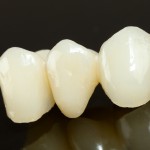
A range of treatment options exists for the replacement of a single missing tooth in the aesthetic zone. This includes traditional fixed dental prostheses (FDPs), implant-supported single crowns (SCI), and resin-bonded FDPs (RBBs).
The aim of this review was to obtain the long-term survival rate of RBBs and to evaluate the incidence of technical, biological, and aesthetic complications over a mean observation period of at least 5 years.
Methods
The review was conducted to update one undertaken by Pjetursson et al. in 2008. A search was conducted on Medline for English and German language prospective and retrospective cohort studies and case series with a minimum of 10 patients and follow up of 5 years or longer. Patients had to have been examined clinically at the follow-up visit. Initial screening of studies was carried out by 2 reviewers independently. Four reviewers independently assessed and abstracted data. Data from the earlier review by Pjetursson et al, was also extracted and checked.
RBB survival was defined as the RBB remaining in situ with or without modification for the entire observation period. Failure being defined as RBBs that were lost and required re-fabrication, or multiple re-cementations representing reconstructions that had been re-cemented more than once. Biological and technical complications were also noted.
Failure and complication rates were calculated by dividing the number of events (failures or complications) in the numerator by the total exposure time (RBB time or abutment time) in the denominator. Event rates for RBBs and/or abutments were calculated for each study. Failure and complication rates were analysed using robust Poisson regression models to obtain summary estimates of 5- and 10-year proportions.
Results
- 29 studies involving 2366 patients were included, 17 from the Pjetursson et al review.
- 15 studies were prospective, 13 retrospective studies, and one a mixture of a pro- and retrospective design.
- A wide range of preparation approaches and materials were used.
- 23 studies reported on survival.
| No. of studies | % annual failure rate (95%CI) | % 5-year survival rate (95%CI) | |
| RBBs Overall | 23 | 1.8 (1.30–2.56) | 91.3 (88–93.7) |
| 5 -7.3 yrs. follow up | 18 | 1.8 (1.13-3.13) | |
| >7.4 yrs. follow up | 5 | 1.88 (1.13–3.12) | |
| Metal–ceramic RBBs | 8 | 1.83 (1.04–3.22) | 91.3 (85.1–94.9) |
| Metal resin | 1 | 2.35 (1.64–3.26) | 88.9 (85.0–92.1) |
| Glass infiltrated ceramic | 1 | 1.37 (0.45–3.18) | 93.4 (85.3–97.8) |
| Glass reinforced ceramic | 1 | 0.95 (0.12–3.40) | 95.3 (84.4–99.4) |
| Densely sintered zirconia | 3 | 0 (0–1.04) | 100 (94.5–100) |
| Composite | 3 | 1.50 (0.15–14.7) | 92.8 (47.9–99.2) |
| Biological complications | No. of studies | % Annual complication rate (95%CI) | % 5-year complication rate (95%CI) |
| Caries | 11 | 0.34 (0.14–0.82) | 1.7 (CI: 0.7–4.0) |
| Recurrent periodontitis | 15 | 0.17 (0.08–0.36) | 0.8 ( 0.4–1.8) |
| Abutment tooth fracture | 18 | 0.03 (0.01–0.10) | 0.2% (0.05–0.5) |
- De-bonding was the most common technical complication 519 out of 2619 RBBs (18.8%). The estimated annual rate was 3.3 (95% CI: 2.3–4.6%), giving a 5-year complication rate of 15% (95% CI: 10.9–20.6%;
- For framework and veneer fractures the overall annual failure rate was 0.34 (95% CI: 0.13– 0.90%), or a 5-year complication rate of 1.7% (95% CI: 0.6–4.4%.
Conclusions
The authors concluded
In specific and clearly defined patient situations, RBBs may be considered as valid minimally invasive treatment alternative to conventional FDPs or single implant crowns. Anterior RBBs made with zirconia frame- works and single-retainer design appear to perform best, yet, other all-ceramic RBBs as well as composite RBBs are very promising as well. Despite the high survival rate of RBBs after 5 years, technical complications such as de-bonding still are frequent.
Comments
This review is limited to a single database and restricted to studies published in two languages so there is the possibility that relevant studies may have been missed. This might be further compounded by difficulties in identifying dental survival analysis articles in the Medline (Layton & Clarke 2016). A recent critical review (Layton 2017) concluded that 95% of prosthodontic and implant review articles failed to use search strategies that were systematic. The review included a wide range of study designs but no quality assessment of the included studies was presented. Consequently, given the range of study designs included and the decision to pool the data means that the findings should be viewed very cautiously.
Links
Primary paper
Thoma DS, Sailer I, Ioannidis A, Zwahlen M, Makarov N, Pjetursson BE. A systematic review of the survival and complication rates of resin-bonded fixed dental prostheses after a mean observation period of at least 5 years. Clin Oral Implants Res. 2017 Feb 13. doi: 10.1111/clr.13007. [Epub ahead of print] Review. PubMed PMID: 28191679.
Other references
Pjetursson, B.E., Tan, W.C., Tan, K., Bragger, U., Zwahlen, M. & Lang, N.P. (2008) A systematic review of the survival and complication rates of resin-bonded bridges after an observation period of at least 5 years. Clinical Oral Implants Research 19: 131–141
Layton DM, Clarke M. Search Strategy to Identify Dental Survival Analysis Articles Indexed in MEDLINE. Int J Prosthodont. 2016 Jan-Feb;29(1):20-7. doi: 10.11607/ijp.4304. PubMed PMID: 26757323.
Layton D. A Critical Review of Search Strategies Used in Recent Systematic Reviews Published in Selected Prosthodontic and Implant-Related Journals: Are Systematic Reviews Actually Systematic? Int J Prosthodont. 2017 Jan/Feb;30(1):13-21. doi: 10.11607/ijp.5193. PubMed PMID: 28085971.
Dental Elf 7th Apr 2016
